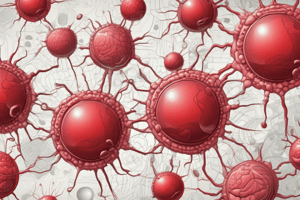Podcast
Questions and Answers
What is the main function of red blood cells?
What is the main function of red blood cells?
- To carry oxygen from lungs to body tissues (correct)
- To produce antibodies
- To regulate blood clotting
- To fight infections
What is the average lifespan of platelets?
What is the average lifespan of platelets?
- Several weeks
- A few months
- 120 days
- 7-10 days (correct)
Which type of white blood cell engulfs and digests foreign particles and bacteria?
Which type of white blood cell engulfs and digests foreign particles and bacteria?
- Monocytes
- Lymphocytes
- Eosinophils
- Neutrophils (correct)
What is the process of blood cell formation called?
What is the process of blood cell formation called?
Which blood cell disorder is characterized by a low red blood cell count or hemoglobin level?
Which blood cell disorder is characterized by a low red blood cell count or hemoglobin level?
Where are blood cells produced?
Where are blood cells produced?
What is the function of hemoglobin in red blood cells?
What is the function of hemoglobin in red blood cells?
What is the main function of platelets in the body?
What is the main function of platelets in the body?
Which type of white blood cell is involved in parasitic infections and allergic reactions?
Which type of white blood cell is involved in parasitic infections and allergic reactions?
What is the term for a genetic disorder affecting blood clotting?
What is the term for a genetic disorder affecting blood clotting?
Flashcards are hidden until you start studying
Study Notes
Blood Cells
Red Blood Cells
- Also known as erythrocytes
- Function: carry oxygen from lungs to body tissues and carbon dioxide from tissues to lungs
- Characteristics:
- Biconcave disk shape
- No nucleus
- Contain hemoglobin (Hb) that binds to oxygen
- Produced in bone marrow
- Average lifespan: 120 days
- Destroyed in spleen and liver
White Blood Cells
- Also known as leukocytes
- Function: part of immune system, help fight infections
- Types:
- Neutrophils: engulf and digest foreign particles and bacteria
- Lymphocytes: produce antibodies to fight infections
- Monocytes: mature into macrophages that engulf foreign particles
- Eosinophils: involved in parasitic infections and allergic reactions
- Basophils: involved in allergic reactions
- Produced in bone marrow and lymphoid organs
- Average lifespan: varies by type (hours to years)
Platelets
- Also known as thrombocytes
- Function: blood clotting, forming plugs to stop bleeding
- Characteristics:
- Small, irregularly-shaped
- No nucleus
- Contain granules that release clotting factors
- Produced in bone marrow
- Average lifespan: 7-10 days
Blood Cell Formation
- Process: hematopoiesis
- Occurs in bone marrow
- Steps:
- Stem cells differentiate into progenitor cells
- Progenitor cells mature into specific blood cell types
- Blood cells released into circulation
- Regulation: controlled by hormones, growth factors, and cytokines
Blood Cell Disorders
- Anemia: low red blood cell count or hemoglobin level
- Leukemia: cancer of white blood cells
- Thrombocytopenia: low platelet count
- Hemophilia: genetic disorder affecting blood clotting
- Sickle cell disease: genetic disorder affecting hemoglobin structure
Blood Cells
Red Blood Cells
- Carry oxygen from lungs to body tissues and carbon dioxide from tissues to lungs
- Characteristics:
- Biconcave disk shape
- No nucleus
- Contain hemoglobin (Hb) that binds to oxygen
- Produced in bone marrow
- Average lifespan: 120 days
- Destroyed in spleen and liver
White Blood Cells
- Part of immune system, help fight infections
- Types:
- Neutrophils: engulf and digest foreign particles and bacteria
- Lymphocytes: produce antibodies to fight infections
- Monocytes: mature into macrophages that engulf foreign particles
- Eosinophils: involved in parasitic infections and allergic reactions
- Basophils: involved in allergic reactions
- Produced in bone marrow and lymphoid organs
- Average lifespan: varies by type (hours to years)
Platelets
- Function: blood clotting, forming plugs to stop bleeding
- Characteristics:
- Small, irregularly-shaped
- No nucleus
- Contain granules that release clotting factors
- Produced in bone marrow
- Average lifespan: 7-10 days
Blood Cell Formation
- Process: hematopoiesis
- Occurs in bone marrow
- Steps:
- Stem cells differentiate into progenitor cells
- Progenitor cells mature into specific blood cell types
- Blood cells released into circulation
- Regulation: controlled by hormones, growth factors, and cytokines
Blood Cell Disorders
- Anemia: low red blood cell count or hemoglobin level
- Leukemia: cancer of white blood cells
- Thrombocytopenia: low platelet count
- Hemophilia: genetic disorder affecting blood clotting
- Sickle cell disease: genetic disorder affecting hemoglobin structure
Studying That Suits You
Use AI to generate personalized quizzes and flashcards to suit your learning preferences.



